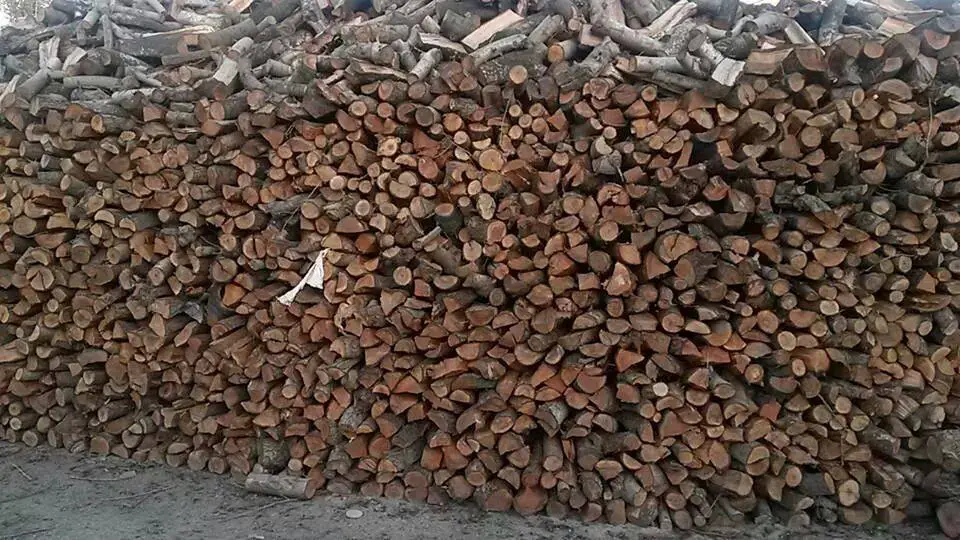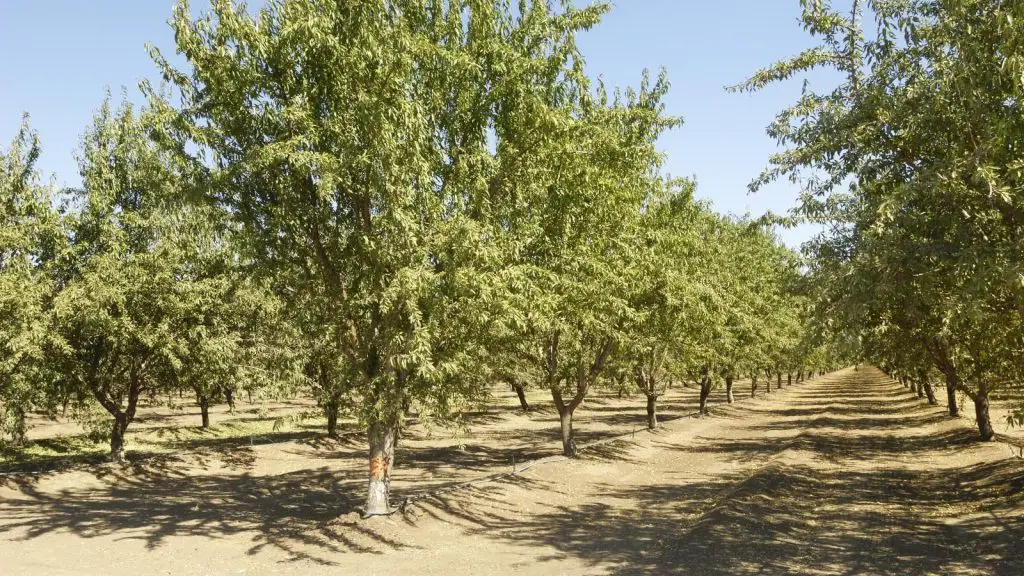Almond firewood burns hot, has a low sap content, and doesn’t produce much smoke, but it is expensive and scarce in some markets.
Depending on the variety of almond you burn, it has a BTU rating like that of oak, a longtime favorite for firewood. However, you’ll find that almond can cost twice as much as oak per cord. Even with the sweet smoke it produces, and the low sap content, almond probably won’t be a first choice for firewood for many people.
Table of Contents
Summary
- Heat Production: 26.7 million BTU/cord
- Weight: 6,980 lb/cord green
- Seasoning Time: 12 months
- Splitting Difficulty: Medium
- Sap Content: Low
- Smoke: Low
- Smell: Pleasant
Almond is an excellent choice for firewood, as its high BTU rating is on par with oak. Almond is a dense wood, which means it will burn hot for a long time. Almond also seasons in just 12 months, where oak can take up to twice that long. Almond wood produces low smoke, and the burning smell is subdued and pleasant.
The issue with using almond for firewood is its scarcity. Almond trees are prized for the nuts they produce, and as such, almond wood hits the market at much lower volumes than other hardwoods. Almond trees are kept in service for as long as they produce nuts, and growers refrain from cutting trees unless it’s necessary.

Heat Production
Almond burns hot, just under 27 million BTU per cord. That’s in the same ballpark as oak, which is a popular firewood choice. Expect almond wood to behave in your stove or firepit similarly to oak or other comparable hard woods. Almond burns down to little ash, since it’s a dense wood. It leaves a small amount of ash, similar to oak.
Smoke Generation
Almond has a low sap content, which means that it doesn’t generate much smoke. That’s good news on the creosote front, as well. Since almond produces little smoke, it’s a good choice for use in outdoor firepits, as well as indoor stoves. Of course, you’ll want good ventilation regardless of what wood you burn in an indoor stove. The smoke that does generate from almond is light and pleasant.
Seasoning Time
One of almond’s selling points is its short seasoning time. Almond can be ready to burn in as little as 12 months. Oak, for example, can take up to 24 months before it’s seasoned. If you burn green wood, it can lead to excess creosote buildup in your chimney, if most of your burning occurs in an indoor stove.
As such, you’ll want a moisture meter to accurately measure the moisture content of your almond wood. They’re not too expensive, and you can easily find one within a reasonable budget.
I personally recommend this General Tools Moisture Meter. It allows you to accurately gauge how wet your firewood is and whether it is sufficiently seasoned. Over time you can also see how quickly the moisture is dropping and how much longer you need to keep your firewood dropping until it is seasoned and ready to burn.
Press the sharp pins into the wood and you will quickly see the readout show the moisture ranging from 5% to 50%. It also has a Low/Mid/High indication depending on whether the wood is dry enough, so you don’t need to remember the actual values.

Burning Smell
Almond produces a faint smell that’s pleasant. It doesn’t linger like smells of other woods. This makes it a great choice for use in outdoor firepits. Remember that the greener a wood is, the more pungent its burning smell will be. When properly seasoned, almond has just a slight smell.
Creosote Buildup
Since almond burns very clean, and at a high temperature, it doesn’t cause high creosote buildup. Additionally, you’ll see very little ash buildup from an almond fire.
Creosote is a black ash that builds up in chimneys and stoves, usually from softer woods. It’s mostly unburnt wood particles that can catch on fire if it’s not regularly cleaned. Burning harder woods that produce little creosote is the safest way to build fires in your fireplace or wood stove.
Splitting Difficulty
Almond is comparable to oak in splitting difficulty. It’s a hardwood that’s fairly straight-grained, so you won’t have a hard time getting it to split. Almond trees grow to about 30 feet tall, with decent trunk widths. So, you won’t have to process a lot of trees to get a good yield of wood.
Different Types/Species
Almond trees are actually native to the Middle East but have since been planted across the world. California’s Central Valley is the world’s leading almond producer, and that’s also where a good deal of almond firewood is sourced.
The two major species of almond you’ll most often find are the Nonpareil and the Monterey. Both the Nonpareil and Monterey almond have identical BTU ratings, sap content, and splitting difficulty.
Almond is a hardwood, and almond trees can top out at about 30 feet in height. Their trunks get to a good width, which means you get a larger yield of firewood from one almond tree than other similar fruit trees like olive.
Since almonds are such a popular food source, almond trees rarely get cut down. Orchards prefer to keep trees alive if possible, which means that a lot of almond firewood on the market is made up of tree trimmings. This is one of the reasons that almond wood is double the cost of oak in many areas.
Almond is also a popular wood for cooking, especially in smokers.

Comparison to Other Wood
Since almond is so similar to oak, we’ll look at how the two woods stack up to each other. We’ll also look at how almond fares when compared to other popular firewood choices.
Almond is a great firewood that burns hot for a long time. Its high cost and low availability make it cost-prohibitive for many people to use it as a regular source of firewood.
| Firewood | Million BTU/Cord (source) | Ease of Splitting | Coals | Overall Quality |
| Almond | 26.7 | Medium | Excellent | Excellent |
| Bur oak | 26.7 | Easy | Good | Excellent |
| Osage orange | 32 | Easy | Excellent | Excellent |
| Olive wood | 27 | Easy | Excellent | Excellent |
While almond is expensive, it is a great firewood choice. It burns long and hot, which are the two key factors in finding a great firewood. It also has a relatively short seasoning time. However, it is double the cost of oak, and has an almost identical BTU/cord rating. That makes oak a more economical choice.
Frequently Asked Questions
Can you burn almond firewood in a firepit outdoors?
Yes, almond is an ideal wood for use in an outdoor firepit. It produces very little smoke, thanks to its low sap content. The smoke that is produced has a slight, but pleasant, aroma.
Is it safe to burn almond firewood in a fireplace indoors?
Almond is great for use in stoves and indoor fireplaces. It burns similarly to oak, so you can expect a long, hot fire with few ashes and little creosote buildup. Almond is a hardwood, so you’ll need to use a softer wood to get it started. Once burning, though, almond produces plenty of heat in a fireplace or stove.
How much does it cost to buy almond firewood?
The price of one cord of almond wood is $500. That price will increase or decrease based on your proximity to the Central Valley in California, where the majority of almond in America is found. Since almonds are a valuable food source, almond trees are rarely cut down. Most almond firewood is made up of trimmed trees from orchards.
Conclusion
Almond is a fantastic choice for firewood. It creates a long-lasting, hot flame, and almond fires produce very little smoke or ash. However, almond firewood is almost double the price of oak per cord, and it can be tough to find in all areas of the country. Even with its low creosote buildup and its popularity in smoking meats, almond wood is usually cost-prohibitive for most people.
